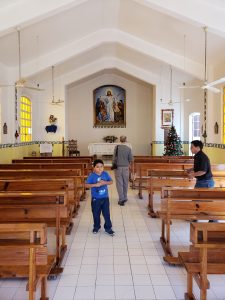
Are we strangers? I think we are, in large part due to our huge language barrier, although social class came into play. Mexican society is hierarchical, and I’m an upper-middle class white lady. I started visiting your parish while teaching at the Universidad de Guadalajara through the Fulbright program in the winter of 2019.
My Episcopal parish in Chicago has a companion relationship with an Anglican church in Cuernavaca, so I visited early in my Mexican stay. Padre Bayron in Cuernavaca is friends with your pastor and suggested that I go visit. Just outside of Guadalajara, he said. Templo San Esteban Mártir (Iglesia Anglicana de México) in the town of San Sebastián el Grande. It could be my Mexican church home, and so I emailed Padre Sergio.
It turned out that even on a Sunday morning, the Uber ride from my suburban apartment took about 40 minutes and included some stretches of dirt road. San Sebastián el Grande is not big; it is a rural town with a population of about 28,000. (It is larger than the other San Sebastián in the state of Jalisco, San Sebastián del Oeste with 1,000 people). It is a traditional Mexican town of low adobe buildings organized around a central plaza in the municipality of Tlajomulco. The tomatoes that show up in American grocery stores in January come from there.
But most weekends, I found myself alone in a city where I was a short-term resident. I didn’t have much to do, and you were so welcoming that I made the trip.
The Anglican Church in Mexico is a province of the Episcopal Church in the United States, but the history is very different. In the US, the Episcopal Church was established by the British colonists and for most of its history was the denomination of the upper classes. More recently it has become a church for people disaffected from other churches, especially LGBTQIA people who feel alienated by the Roman Catholic church.
In Mexico, the Roman Catholic Church is the church of the colonizers. The Iglesia Anglicana de México was founded to reform the Catholic church in the wake of Mexico’s revolution. It grew thanks to Welsh miners who showed up in Mexico with both their church and their national religion, soccer (it’s called fútbol, not pie pelota) and a series of former Roman Catholic priests who wanted to have a wife and children in public, Padre Bayron and Padre Sergio among them. San Esteban Mártir was founded 95 years ago and is independent of mission support, eking by as it seemed almost everyone in your town does.
The cliché story would be that we crossed our wide chasm of social class, education, and nationality to become the best of friends. That didn’t happen. My spoken Spanish is not that good, and it is formal: learned in classrooms for use in classrooms. My accent announces my nationality before anyone even glimpses my passport. I’m not sure you even knew what I was doing at your church. Padre Sergio and I had originally communicated through email, giving me time to check my grammar, but once I showed up? Yikes.
And yet, I appreciated that I had a place to go during my time in Guadalajara. I was welcomed, even though I didn’t fit in. I could usually understand the sermon (the language of the pulpit being more formal than that of coffee hour), which gave me the opportunity to learn a little something about the culture. For example, the Sunday before the penitential season of Lent, Padre Sergio reminded everyone that just because it starts with a carnival and ends with the Semana Santa vacation season (the week before and after Easter), Lent was not a season of joy.
I never heard that in an American church, where the Lenten traditions of receiving ashes and giving something up are taken seriously. A Midwestern Easter is as likely to be snowy as sunny. Easter may be holy, but it’s not as festive as Christmas.
But then I thought about it. Penitence means something different in a nation where 46% of people live below the poverty line. Giving up meat is no big deal in place with 9,330 kilometers of coastline and a cuisine that celebrates seafood. Not all those beaches have been taken over by glitzy all-inclusive resorts, either. If you can afford to go camping, you can afford to take a beach vacation during Semana Santa, and people do.
Celebrations are important because life is hard. One day, I saw on the TV news that 17 bodies were found in a house in San Sebastián el Grande. They were victims of cartel violence, a serious problem in and around Guadalajara. El Chapo may be in prison, but the Cartel Jalisco Nueva Generacíon is continuing his work. People are getting hurt and communities are being destroyed.
I freaked out when I found out how close the violence was to people I knew. So, are you strangers?
We had a form of connection. The whole point of communal worship is to bring people together so that they can learn from each other as well as from the holy texts. I know the Book of Common Prayer in English, so I could follow along even though I was a short-term visitor who spoke little Spanish.
I brought cookies for coffee hour, put money in the collection basket, and replied when the children practiced their basic “Hello. How are you?” conversation. You were my home during my time in Guadalajara.
Thank you for having me.


